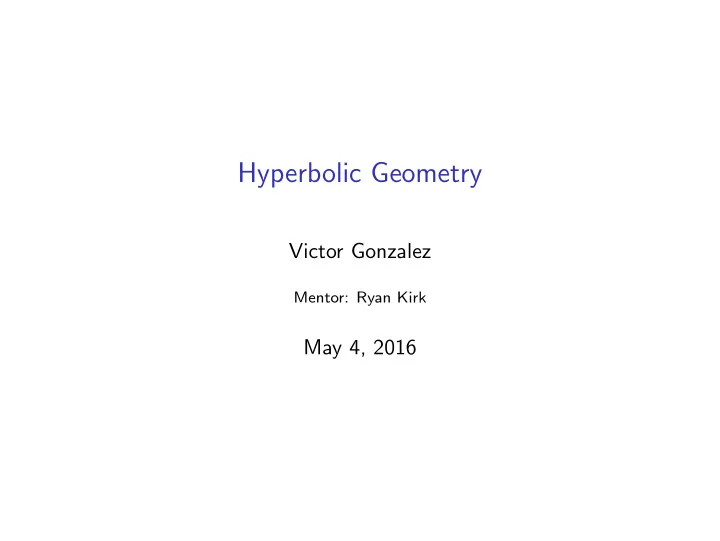

Hyperbolic Geometry Victor Gonzalez Mentor: Ryan Kirk May 4, 2016
Hyperbolic Geometry We are all familiar with Euclidean Geometry. It’s the type of geometry that represents the world we live in today. But there are other types of geometry, and the one we will focus on is called hyperbolic geometry. ◮ One model of hyperbolic space is the open upper half plane of C . This model for H is defined as the set H = { z ∈ C : ℑ ( z ) > 0 } Suppose you have a line, ℓ , in H , and a point z not on ℓ . In hyperbolic space, there are infinitely many lines containing z that are parallel to ℓ .
Straight Lines Straight lines in hyperbolic geometry take up two forms: and
Distance We want to be able to measure the distance between two points in hyperbolic space. There exists a formula for it! Suppose f : [ a , b ] → H is a path in H . Then the length of that path that connects two points in H is defined by the integral: � b 1 ℑ ( f ( t )) | f ′ ( t ) | dt length H ( f ) = a Consider the set of all paths connecting two points z , w ∈ H , denoted as Γ[ z , w ]. We define the distance between two points as d ( z , w ) = inf { length H ( f ) | f ∈ Γ[ z , w ] }
Angles There is a way to measure the angles in hyperbolic geometry. We make use of the tangent lines at the point of intersection between two lines. For example:
Angles There is a way to measure the angles in hyperbolic geometry. We make use of the tangent lines at the point of intersection between two lines. For example:
Angles There is a way to measure the angles in hyperbolic geometry. We make use of the tangent lines at the point of intersection between two lines. For example:
Different Triangles in H
Gauss-Bonnet Formula Suppose we are given a triangle, T, in hyperbolic space with angles α , β and γ . Then the area of the triangle is given by the formula: area(T) = π − ( α + β + γ ) And we can use this formula to find the area of any n -sided polygon in hyperbolic space.
Law of Cosines The law of cosines in hyperbolic space is different than in Euclidean space. For a triangle with hyperbolic lengths of sides a , b , c and interior angles α , β , and γ , the hyperbolic law of cosines is cosh( a ) = cosh( b ) cosh( c ) − sinh( c ) sinh( b ) cos( α )
Example Question: Imagine you are taking a penalty kick in hyperbolic space. What is the maximum angle you can kick the ball and still have a chance of scoring? Goal c = 4 yards b = 12 yards γ a = ?
Example cosh( a ) = cosh( b ) cosh( c ) − sinh( c ) sinh( b ) cos( α )
Example cosh( a ) = cosh( b ) cosh( c ) − sinh( c ) sinh( b ) cos( α ) a = cosh − 1 (cosh(4) cosh(12)) ≈ 15 . 307
Example cosh( a ) = cosh( b ) cosh( c ) − sinh( c ) sinh( b ) cos( α ) a = cosh − 1 (cosh(4) cosh(12)) ≈ 15 . 307 � � − cosh(4) − cosh(12) cosh(15 . 307) γ = cos − 1 ≈ (7 × 10 − 4 ) ◦ sinh(12) sinh(15 . 307)
Penalty Kick in H Goal c = 4 yards b = 12 yards γ a ≈ 15.307 yards γ ≈ (7 × 10 − 4 ) ◦
Recommend
More recommend